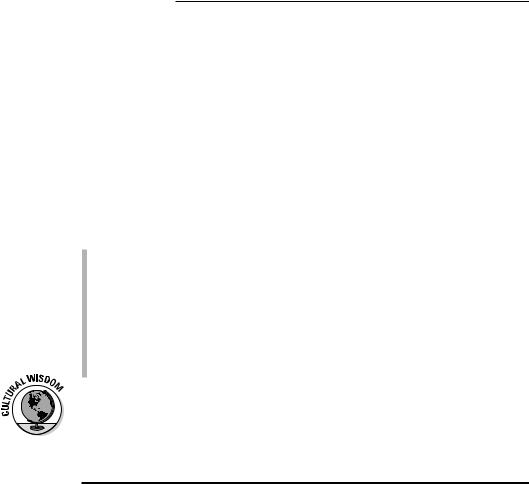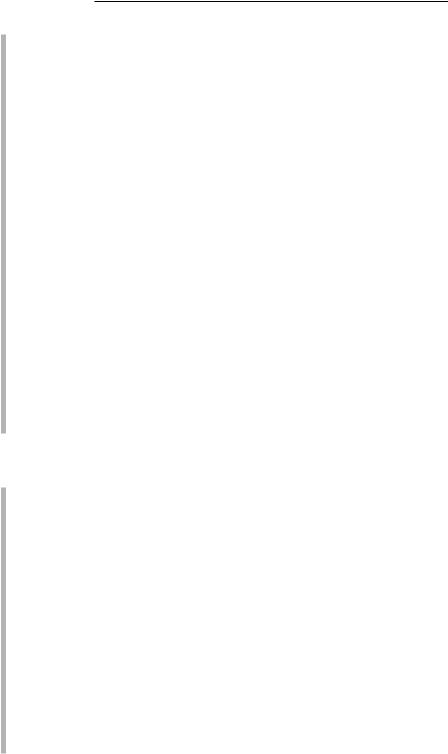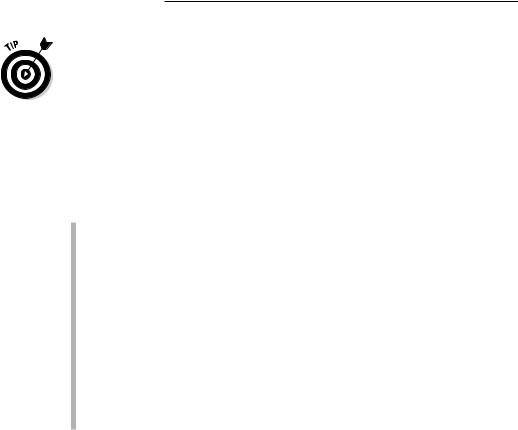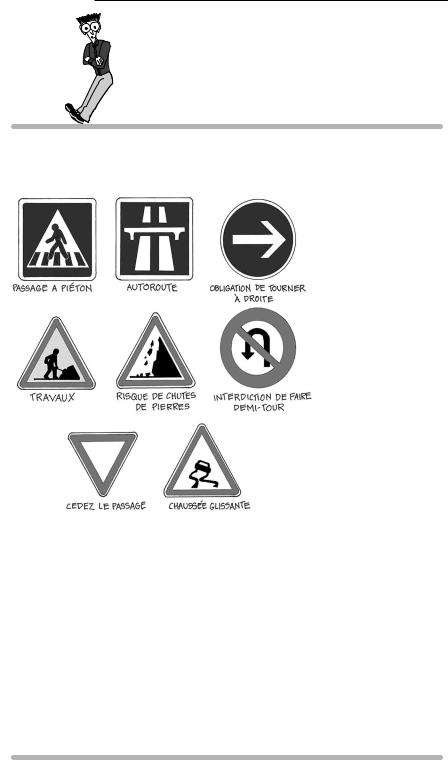
- •About the Authors
- •Dedication
- •Acknowledgments
- •Table of Contents
- •Introduction
- •About This Book
- •Conventions Used in This Book
- •Foolish Assumptions
- •How This Book Is Organized
- •Icons Used in This Book
- •Where to Go from Here
- •The French You’re Familiar With
- •Idioms and Popular Expressions
- •Key Parts of Speech
- •Cavorting with Verbs
- •Forming Sentences and Questions
- •The French Alphabet
- •Uttering Vowel and Consonant Sounds
- •Greetings: Formal and Friendly
- •Asking Questions to Get to Know People
- •Counting Your Lucky Stars: Numbers
- •Using the Calendar and Dates
- •Telling Time in French
- •Discussing Where You Live with the Verb “Habiter”
- •Discussing Daily Routine with Reflexive Verbs
- •Using Possessive Adjectives to Introduce Your Family Members
- •Basic Questions and Polite Expressions
- •Stating Your Preferences
- •Talking about Your Livelihood
- •Chatting about the Weather
- •Deciding to Keep in Touch
- •Getting Direction about Directions
- •Dining Out
- •Going to the Market
- •Going Shopping
- •Going Out with the Verb “Sortir”
- •Having Fun with the Verb “S’amuser”
- •Oh, the Places You’ll Go!
- •Making Plans with Friends
- •Making a Phone Call
- •Livin’ in the Past: Using the Past Tense
- •Playing Sports and Games
- •Going to the Beach
- •Setting Up Camp
- •Enjoying Quieter Pursuits
- •Where Do You Want to Go?
- •Getting Ready for Your Trip
- •Getting Current with Currency
- •Going to the Bank
- •Using Credit Cards and ATMs
- •Getting through the Airport
- •Navigating Buses, Trains, and Subways
- •Getting Around by Car
- •Finding Accommodations
- •Checking In to a Hotel
- •Checking Out of a Hotel
- •Getting Help Fast
- •Getting Medical Help
- •Handling Legal Matters
- •Label the Things in Your House
- •Write Your Shopping Lists in French
- •Listen to French Music
- •Watch French Movies
- •Tune in to TV5
- •Read French Publications
- •Take a Class
- •Join a French Association
- •Join an Online Chat or Pen Pal Forum
- •Using “Tu” When You Mean “Vous”
- •Using “Bonne nuit!” for Good-Bye
- •Using “Garçon” or “Porteur” to Address Service Staff
- •Saying “Je suis excité(e)” to Indicate Excitement
- •Saying “Je suis chaud(e)/froid(e)” to Say You’re Hot or Cold
- •Saying “Je suis plein/e” to Mean You’re Full
- •Using “de la glace” to Request Ice
- •Using “Je suis . . . ans” to Tell Your Age
- •Asking for Change with “J’ai besoin de change”
- •Using the Verb “Visiter” in Reference to People
- •“À mon avis”
- •“C’est pas vrai”
- •“Avec plaisir”
- •“C’est génial”
- •“À votre santé”
- •“À vos souhaits”
- •“Quelle horreur!”
- •“À bientôt”
- •“Passez-moi un coup de fil!”
- •“On y va!” or “Allons-y!”
- •“Je n’en sais rien”
- •“Je n’en reviens pas”
- •“Ça vaut la peine”
- •“C’est pas grave”
- •“N’importe”
- •“Tu cherches midi à 14h”
- •“Prenons un pot!”
- •Regular French Verbs
- •Auxiliary French Verbs
- •Track Listing
- •Customer Care
- •Index

Chapter 15: Getting Around: Planes, Trains, Taxis, and More 253
L’employé: C’est pour combien de personnes?
seh poohr kohN-byaN duh pehr-sohhn?
For how many people?
Susan: Pour une personne, monsieur. poohr ewn pehr-sohhn, muh-syuh.
For one person, sir.
L’employé: Vous avez de la chance. J’ai encore une place. Ça fait douze euros.
vooh-zah-vey duh lah shahNs. zhey ahN-kohr ewn plahs. sah feh doohz uh-roh.
You’re lucky. I still have one seat. That’ll be 12 euros.
Susan: Est-ce que je dois changer de train? ehs-kuh zhuh dwah shahN-zhey duh traN?
Do I have to change trains?
L’employé: Oui, vous avez une correspondance à Issy.
wee, vooh-zah-vey ewn koh-reh-spohN-dahN-sah ee-see.
Yes, you have a connecting train in Issy.
Susan: Et de quel quai part le train? ey duh kehl key pahr luh traN?
And from which platform does the train leave?
L’employé: Quai 12A.
key doohz ah.
Platform 12A.
Susan: Merci. Au revoir. mehr-see. ohr-vwahr. Thank you. Good-bye.
Getting Around by Car
If convenience and fast service are more important to you than paying the fare, then taking a taxi is a good way to get around. Or, if you’re more adventurous and like driving, you may want to rent a car. This way, you can stop wherever you want, visit local towns, meander through the marchés (mahr-shey) (outdoor markets), and change plans according to the weather or your
mood. The following sections tell you what you need to know.
www.ATIBOOK.ir

254 Part III: French on the Go
Hailing a taxi
Taxis are readily available at all airports and train stations, as well as all over major cities. Although taxis come in all colors, depending on the country you are visiting, they are easily recognizable because of the international word on them: Taxi. (Keep in mind though, that taxis have a passenger as well as a luggage limit.)
Although many taxi drivers in large international cities have a basic knowledge of English, have your destination address printed out to avoid any misunderstandings. Be prepared to pay in cash because some taxis do not take credit or debit cards.
The following terms and phrases are ones you’ll use when you take a taxi:
le chauffeur de taxi (luh shoh-fuhr duh tah-ksee) (cab driver)
le tarif (luh tah-reef) (fare)
la station de taxi (lah stah-syohN duh tah-ksee) (taxi stand)
Où voulez-vous aller? (ooh vooh-ley-vooh-zah-ley?) (Where do you want to go?)
Je voudrais aller à. . . . (zhuh vooh-dreh-zah-ley ah….) (I would like to go to. . . .)
Tipping is optional in Belgium, although it is customary to round up to the nearest euro, but in other European countries, expect to leave about a 10 percent tip.
Talkin’ the Talk
Karen and Derek want to take a taxi from the airport to their hotel. They were lucky enough to get the attention of a taxi driver right away.
Le chauffeur Où voulez-vous aller?
de taxi: ooh vooh-ley-vooh-zah-ley?
Where do you want to go?
Karen: Bruxelles, Hôtel Gillon, s’il vous plaît. brewk-sehl, oh-tehl zhee-lohN, seel vooh pleh.
Brussels, Hotel Gillon, please.
Le chauffeur Avec plaisir. C’est dans quelle rue?
de taxi: ah-vehk pleh-zeer. seh dahN kehl rew?
With pleasure. Which street is that on?
www.ATIBOOK.ir

Chapter 15: Getting Around: Planes, Trains, Taxis, and More 255
Derek: Voyons . . . c’est 22 rue Albert. C’est combien? vwah-yohN. . . seh vaNt-duh rew ahl-behr. seh kohN-byaN?
Let’s see . . . it’s 22 Albert Street. How much is it?
Le chauffeur 35 euros. C’est le tarif normal. Est-ce que je mets de taxi: les valises dans le coffre?
trahN-saNk uh-roh. seh luh tah-reef nohr-mahl. ehs-kuh zhuh meh ley vah-leez dahN luh koh-fruh.
35 euros. That’s the normal fare. Do I put the suitcases in the trunk?
Karen: Très bien, mais je garde mon sac à dos avec moi. treh byaN, meh zhuh gahrd mohN sahk ah doh ah-vehk mwah.
Very well, but I am keeping my backpack with me.
Words to Know
la rue |
lah rew |
the street |
C’est combien? |
seh kohN-byaN? |
How much is it? |
je mets |
zhuh meh |
I put |
le coffre |
luh koh-fruh |
the trunk (of a vehicle) |
garder |
gahr-dey |
to keep |
le sac à dos |
luh sahk ah doh |
backpack |
Driving in a foreign land
Louer une voiture (looh-ey ewn vwah-tewr) (renting a car) in Europe may be a little more expensive than renting one in the U.S. However, if you share the car with two or three others, this option may be less expensive than purchasing individual rail passes. If you decide to rent a car and drive yourself, it is always best to do your research and to talk to your rental agency about your travel plans. Keep these points in mind:
www.ATIBOOK.ir

256 Part III: French on the Go
The minimum driving age for car rentals in Europe is between 21 and 25, and the maximum age is usually 70. If you are a younger or older driver, you may be asked to pay additional insurance against collision damage.
Purchasing additional insurance anyway just for your peace of mind may be a good idea, but that is totally up to you. Check with your credit card company to see whether they cover the insurance on rental cars.
When you are renting a car, make sure you tell the agency about your travel plans because some agencies may have border restrictions or limits and you may need to pay extra insurance fees for this. Also if you are renting a car in one country and would like to drop it off in another, you may be required to pay drop-off fees.
In most countries all you need is your normal, valid driver’s license. In others, they may ask you for your International Drivers’ Permit, or IDP, which is basically a translation of your license in many different languages. It is a good idea to get an IDP anyway, especially if you are not certain where your car travels may take you or if you are stopped by the police. You can purchase an IDP for about $15.00 at any automobile association which is authorized by the Department of State to issue IDPs, such as AAA or CAA. You need two passport photos as well as your valid driver’s license to get an IDP.
Many French autoroutes (oh-toh-rooht) (highways) require des péages (dey pey-ahzh) (tolls), and they are not cheap. Always have coins handy, although most of the time you pick up a ticket at the point of entry and pay at the exit. In France, tollbooths usually accept credit cards: Just insert your ticket into a machine at the tollbooth, then your credit card, wait, get your receipt, and make sure you pull your card out again.
Here are some words and phrases related to driving and la circulation (lah seer-kew-lah-syohN) (traffic):
le rond-point (luh rohN-pwaN) (roundabout)
le stationnement/le stationnement interdit (luh stah-syohNn-mahN/ luh stah-syohNn-mahN aN-tehr-dee) (parking/no parking)
le piéton/la piétonne (luh pyey-tohN/lah pyey-tohhn) (pedestrian)
le trottoir (luh troh-twahr) (sidewalk)
la sortie (lah sohr-tee) (exit)
le carrefour (luh kahr-foohr) (intersection)
l’embouteillage (lahN-booh-teh-yahzh) (traffic jam)
le sens unique (luh sahNs ew-neek) (one way)
le pont (luh pohN) (bridge)
ralentir (rah-lahN-teer) (to slow down)
rouler vite (rooh-ley veet) (to drive fast)
demi-tour (duh-mee-toohr) (U turn)
www.ATIBOOK.ir

Chapter 15: Getting Around: Planes, Trains, Taxis, and More 257
Filling up at the gas station
As you probably are aware, faire le plein (fehr luh plaN) (to fill the gas tank) in Europe, or in France specifically, costs more than it does here at home. Don’t get too excited when you see postings at the station-service (stah-syohN-sehr- vees) (gas station) for 1.55; that’s in euros and per liter, not per gallon. A gallon of essence (eh-sahNs) (gas) is 3.78 liters. Although gas prices fluctuate, gas is usually cheaper at supermarkets and hypermarkets than it is on major highways.
Just like in North America, in France you have a choice of sans-plomb (sahN-plohN) (unleaded), ordinaire (ohr-dee-nehr) (regular unleaded), super (sew-pehr) (super unleaded), and gazole/diesel (gah-zohl/dyey-zehl) (diesel).
If you travel to Europe, make sure you’re familiar with the metric system and its three most common units: the meter, the gram, and the liter. One kilometer equals 0.621 of a mile. For example, from the center of Paris to Versailles is about 21 kilometers, or approximately 13 miles. For more information on weights, check out Chapter 8.
Gas stations on the major highways do have des pompistes (dey pohN-peest) (gas station attendants), but others may not. Generally, you pump your gas first and then pay. Although you can pay a cashier with a credit card, a credit card may not work in the automated machines. Some European countries, including France, have adapted “chip-and-pin cards,” which are the only ones accepted at self-serve pay at the pump stations.
The following little phrases can help you out when you are looking to fill up the tank:
Où est-ce qu’il y a une station-service? (ooh ehs-keel ee ah ewn stah- syohN-sehr-vees?) (Where is there a gas station?)
Est-ce qu’il y a une station-service près d’ici? (ehs-keel ee ah ewn stahsyohN sehr-vees preh dee-see?) (Is there a gas station near here?)
Le plein, s’il vous plaît. (luh plaN, seel vooh pleh.) (Fill it up, please.)
When talking about unspecified quantities, French uses an article called the partitif (pahr-tee-teef) (partitive) because it describes a “part” of a quantity. You construct it by combining the preposition de (of) and the definite article le, la, les:
de + le = du (dew)
de + la = de la (duh lah)
de + les = des (dey)
de + l’ = de l’ (duhl)
You can translate these constructions as some, as in this example: Je voudrais du carburant (zhuh vooh-dreh dew kahr-bew-rahN) (I would like some fuel.) Check out Chapter 2 for more on the partitive.
www.ATIBOOK.ir

258 Part III: French on the Go
Here’s a little advice: Fill up during the day at a manned station and keep some cash on hand in case the automated machines don’t accept your credit card. Also be aware that gas stations in town may be closed on Sundays. This is not the case on the highways.
Getting help when you have car trouble
Hopefully, your journey will be smooth and trouble-free, but in the event you have car trouble or see un avertisseur lumineux (uhN ah-vehr-tee-suhr lew- mee-nuh) (a warning light), you may need to talk to un mécanicien (uhN mey- kah-nee-syaN) (a mechanic). Here are some words and phrases that can help you identify what the trouble is:
la batterie (lah bah-tree) (battery)
le capot (luh kah-poh) (the hood)
l’essuie-glace (ley-swee-glahs) (windshield wiper)
les freins (ley fraN) (the brakes)
le pare-brise (luh pahr-breez) (windshield)
les phares (ley fahr) (headlights)
le pneu/le pneu crevé (luh pnuh/luh pnuh kruh-vey) (tire/flat tire)
tomber (être) en panne (tohN-bey [eh-truh] ahN pahn) (to break down [car])
vérifier (les niveaux) (vey-ree-fyey [ley nee-voh]) (check [the levels])
la vidange (lah vee-dahNzh) (oil change)
Deciphering road signs
You can’t travel safely on your own without being able to understand les panneaux routiers (ley pah-noh rooh-tyey) (road signs). Although many signs are easily recognizable — like the stop and yield signs — others have less obvious meanings. You must review these before you get behind the wheel. The following information is a good start.
To avoid une contravention (ewn kohN-trah-vahN-syohN) (a ticket), keep in mind that les limitations de vitesse (ley lee-mee-tah-syohN duh vee-tehs) (speed limits) in France (indicated by a round sign with a red border) are approximately 80 mph or 130 km/h on the highways, 55 mph or 90 km/h
www.ATIBOOK.ir

Chapter 15: Getting Around: Planes, Trains, Taxis, and More 259
on open roads, and 30 mph or 50 km/h in the city. Speed limits are strictly enforced, and you pay a fine on the spot. Also the traffic arriving on the right always has la priorité à droite (lah pree-oh-ree-tey ah dwaht) (the right of way; Literally: priority to the right).
Here are some important signs that you have to be aware of:
arrêt (ah-reh) (stop)
cédez le passage (sey-dey luh pah-sahzh) (yield)
chaussée rétrécie (shoh-sey rey-trey-see) (road narrows)
chaussée glissante (shoh-sey glee-sahNt) (slippery road)
interdiction de faire demi-tour (aN-tehr-dee-ksyohN duh fehr duh-mee- toohr) (no U Turn)
passage interdit (pah-sahzh aN-tehr-dee) (no entry)
passage piéton (pah-sahzh pyey-tohN) (pedestrian crossing)
risque de chutes de pierre (reesk duh shewt duh pyehr) (falling rocks)
sens unique (sahNs ew-neek) (one way)
travaux (trah-voh) (road work)
virage à droite/virage à gauche (vee-rahzh ah dwaht/vee-rahzh ah gohsh) (bend to the right/bend to the left)
Road signs are distinguishable by shape, color, and by graphics. Here are a few you should become familiar with:
Triangles with a red border indicate a warning or a danger. Example:
Chaussée glissante.
Round signs with a thick red border indicate restrictions. Example:
Interdiction de faire demi-tour.
Round signs with blue background indicate what you are required to do. Example: obligation de tourner à gauche.
Square and rectangular signs guide you. Example: Autoroute (oh-toh- rooht) (highway), which always begins with a capital A (for Autoroute) followed by the highway number.
www.ATIBOOK.ir

260 Part III: French on the Go
Fun & Games |
One part of driving safely is understanding and obeying road signs. To see how well you’d do on a French road, match each French road sign to its English translation.
1._____Road Work |
A. Obligation de tourner à droite |
|
2._____Pedestrian crossing |
B. Autoroute |
|
3._____Slippery road |
C. Interdiction de faire demi-tour |
|
4._____Right turn only |
D. Chaussée glissante |
|
5._____Highway |
E. Cédez le passage |
|
6._____Yield |
F. Passage piéton |
|
7. |
_____No U turn |
G. Risque de chutes de pierres |
8. |
_____Falling rocks |
H. Travaux |
www.ATIBOOK.ir
